*) How it all started
Before we take a closer look at electroacoustic music and its pioneers, we start with the trigger for electroacoustic music.
Mechanics is the study of movement and basically the beginning of a new direction in music. In the 17th century mechanics was at its technological prime as a result of which music on cylinders was created. An instrument of Absolute Musik – no musician is required, paving the way for electroacoustic music.
*) Before 1800 - Mechanics as a Trailblazer

A precursor in Austria was Wolfgang von Kempelen who acquired renown with his Speaking Machine (1769). International pioneers were Václav Prokop Diviš (CZ), famous for his Instrument "Denis d'or“ [Golden Dionysius] (1748) and Jean-Baptiste Delaborde (FR), known for his electric harpsichord "Clavessin électrique" (1759).
image description:Speaking Machine from Wolfgang von Kempelen
source: http://www.deutsches-museum.de
*) von 1800 bis 1900 - From Mechanics to Electrics
In 1856 the first transatlantic cable was put into operation promoting telegraphy. The light bulb had already been invented and the electric revolution was on the rise.
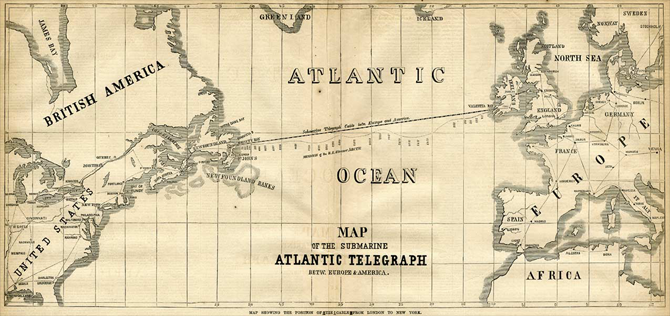
image description: map of the submarine Atlantic Telegraph between Europe and America
source: http://atlantic-cable.com
Matthäus Hipp (CH) was known for many inventions of electronic devices, one of which was the “electromechanical piano” (1867), probably being the first electronic instrument. Elisha Geay (USA) would have been the inventor of the telephone, had he applied for a patent before Alexander Graham Bell. Nonetheless he went down in history as the innovator of the first electronic instruments. He build the “Musical Telegraph” in 1874 and went on tour with it. Thaddeus Cahill (USA) and his “Telharmonium” and William Duddell (UK) and his “Singing Arc” were pioneers of electronic instruments as well.
1899: the new sound carrier emerged – the audio tape
*) 1900 to 1950 - Theremin and Trautonium
More and more musicians and others interested in technology started building electronic musical devices. In the 1920ies and 30ies the building of electronic musical devices was booming. In 1921 the Russian physician Lew Termen presented his musical instrument – the theremin – which is played without touching.
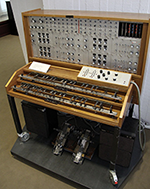 In 1930 Friedrich Trautwein (*1888 †1956) and Oskar Sala (*1910 †2002) co-developed the first prototype of the trautonium. Due to the high prices the production of the volkstrautonium was ceased after 200 units.
In 1930 Friedrich Trautwein (*1888 †1956) and Oskar Sala (*1910 †2002) co-developed the first prototype of the trautonium. Due to the high prices the production of the volkstrautonium was ceased after 200 units.
The theremin and the trautonium became very famous due its use in film music. In the pre-war period the theremin was audible in “King Kong” (1933) and “Bride of Frankenstein” (1935). Later on it was mainly used in Sci-Fi films such as ”The Day The Earth Stood Still” (1951). The trautonium was used in Alfred Hitchcock’s “The Birds” (1963) and George Lucas’ “Star Wars: Episode III – Revenge of the Sith”.
image description: Trautonium
source: http://de.wikipedia.org User: Morn the Gorn
Both instruments were precursors of the synthesizer and encouraged Robert Moog to build the first synthesizer. Nowadays Moog Music Inc. is the most important manufacturer of Thermini. (reference to Austria: In 1984 Robert Moog was presiding over the jury of the “Grand Prix Ars Electronica” in Linz.)
*) 1950ies - The Beginning of Electroacoustic Music
The birth of electroacoustic music lies in the beginning of the Musique Concrète in Paris.
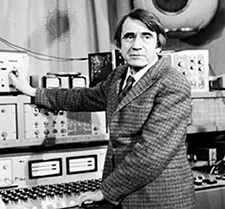 Pierre Schaeffer (*1910 †1995) experimented with everyday noises and recorded them on vinyl records. When tape recorders were more affordable, he recorded on audio tapes. By manipulating the playback speed and the running direction he discovered new sound compositions – Musique Concrète was born.
Pierre Schaeffer (*1910 †1995) experimented with everyday noises and recorded them on vinyl records. When tape recorders were more affordable, he recorded on audio tapes. By manipulating the playback speed and the running direction he discovered new sound compositions – Musique Concrète was born.
The discovery triggered a dispute with the at the same time emerging electronic music from Cologne.
image description: Pierre Schaeffer at Studio 54
source: http://www.songsofthecosmos.com
Karlheinz Stockhausen (*1928 †2007), who is said to be the pioneer of electronic music, was working at the Kölner Studio für Elektronische Musik - Cologne Studio for Electronic Music. He is viewed of one of the most important musicians establishing this genre. He started out composing on tapes, evolving to live electronics through the usage of ring modulators, acoustic filters, distortion, etc. Since 1984 he has been using synthesizers in his performances. Karlheinz Stockhausen is an honorary member of the Deutsche Gesellschaft für Elektroakustische Musik (DEGEM) – the German Society for Electroacoustic Music.
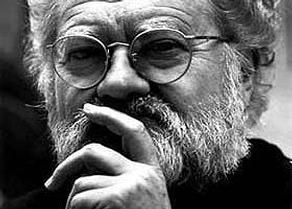 Another pioneer of electroacoustic music is Pierre Henry (*1927). Just as Karlheinz Stockhausen he is viewed as one of the godfathers of techno music and a precursor of the Musique Concrète. In the early 1950ies he was working at the Club D’Essai Studio of the ORTF in France. Together with Schaeffer Henry produced the “Symphonie pour un homme seul” [Symphony for a lonely man] causing a sensation at the premiere, because the piece was introduced without score.
Another pioneer of electroacoustic music is Pierre Henry (*1927). Just as Karlheinz Stockhausen he is viewed as one of the godfathers of techno music and a precursor of the Musique Concrète. In the early 1950ies he was working at the Club D’Essai Studio of the ORTF in France. Together with Schaeffer Henry produced the “Symphonie pour un homme seul” [Symphony for a lonely man] causing a sensation at the premiere, because the piece was introduced without score.
With “Psyché Rock” he turned towards rock music. This opus, in an amended form, was also the theme song of “Futurama”.
image description: Pierre Henry
source: http://www.laut.de/Pierre-Henry
 Not just in Europe electronic music was changing, the USA was also progressing. The married couple Louis and Bebe Barron occupied themselves with the possibility of the audiotape for music productions in their own professional recording studio.
Not just in Europe electronic music was changing, the USA was also progressing. The married couple Louis and Bebe Barron occupied themselves with the possibility of the audiotape for music productions in their own professional recording studio.
In the early 1950ies John Cage and Earle Brown produced the “Project of Music for Magnetic Tape” in their studio. Later the soundtrack to the Sci-Fi film “Forbidden Planet” (1956) was created there. It bears mentioning that this was the first electronic soundtrack of its kind and the audience was ecstatic.
image description: Louis and Bebe Barron at recording studio
source: http://www.lightindustry.org
Even though the Theremin is used for film music, the Barron’s masterpiece is not recognised as music by the American Federation of Musicians but rather written off as electronic tonalities thus excluding it for an Oscar nomination.
Electroacoustic music becomes the generic term for electronic music, acousmatic, Musique Concrète and computer music.
*) Electroacoustic in Austria
In the 1960ies there was a vastly unknown Austrian musician, who only now (mainly due to the reappraisal of Elisabeth Schimana) regained prominence.
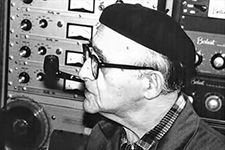 Max Brand (*1896 †1980) was an Austro-American composer and pioneer of music with a synthesizer. In the 1960ies he met Robert Moog, who built him his first synthesizer, the “Moogtonium”. It is the oldest still functioning synthesizer and it is located at the Max Brand Archives (Museum of Langenzersdorf).
Max Brand (*1896 †1980) was an Austro-American composer and pioneer of music with a synthesizer. In the 1960ies he met Robert Moog, who built him his first synthesizer, the “Moogtonium”. It is the oldest still functioning synthesizer and it is located at the Max Brand Archives (Museum of Langenzersdorf).
In his last will and testament Max Brand decreed that a foundation be set up that annually awards composers of electronic music with the Max-Brand Price.
image description: Max Brand
source: Max Brand Archive Langenzersdorf
Another important Austrian synthesizer player was Dieter Feichtner (*1943 †1999), who was a close friend of Günther Rabl and mainly became famous in the 1970ies with the Sureman Trio.
In Austria the initiator of electroacoustic music, how it was known from its Parisian beginnings, was Dieter Kaufmann:
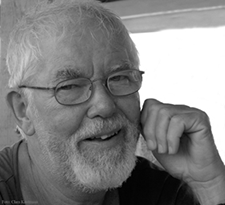 Dieter Kaufmann (*1941) is a composer who imported electroacoustic music from France into Austria. He studied electroacoustics at the Paris Conservatory and at the Groupe de Recherches Musicales under François Bayle and Pierre Schaeffer.
Dieter Kaufmann (*1941) is a composer who imported electroacoustic music from France into Austria. He studied electroacoustics at the Paris Conservatory and at the Groupe de Recherches Musicales under François Bayle and Pierre Schaeffer.
In 1975 he co-founded the K&K Experimentalstudio with his wife and his friend Walter Stangl. He acted as vice president and president in the 1970ies and 80ies respectively for the International Society for Contemporary Music (Section Austria). Between 1991 and 2006 he was chairman of the Department of Electroacoustics and Experimental Music.
image description: Dieter Kaufmann
source: www.radiofabrik.at
Yet another pioneer of electroacoustic music in Austria was Günther Rabl. With the premiere auf “Mugl entsteigt I” in Paris in 1977 he was one of the first tape musicians to understand and further his trade. He also put his knowledge into his self-programmed software.
*) Influences on Pop Music
Many popular music styles, such as Techno, Electro-Pop, Hip-Hop, Synthie Pop, Progressive Rock, Psychodelic Rock, Krautrock, Minimal, House, New Age, Fusion, Funk, Electro Funk, New Wave, Electronic Body Music, Jersey House and others are influenced.
